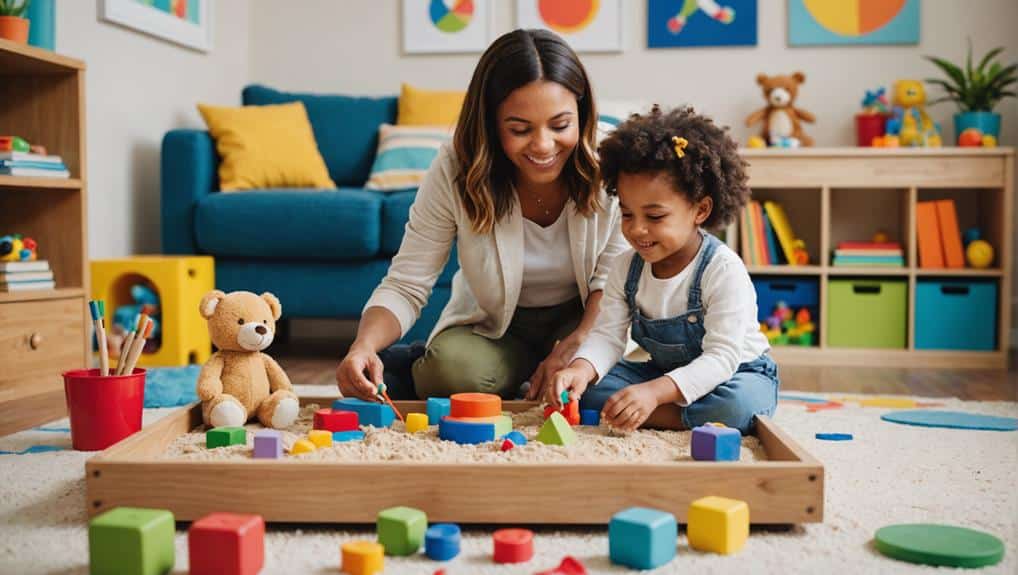Play-based therapy, especially child-led approaches, has recently gained considerable traction in child psychology. These approaches cultivate a child’s ability to express themselves and contribute to their general growth and learning. A growing body of evidence suggests that these therapies foster autonomy, improve problem-solving skills, and provide a safe environment to investigate emotions. Yet, one may wonder, what specific reasons make this therapy especially effective? An in-depth investigation into this subject may yield some insightful revelations.
Key Takeaways
- Play-based therapy fosters creativity and problem-solving skills, enhancing cognitive development.
- It provides a supportive environment for emotional understanding, reducing anxiety and improving self-esteem.
- It is an effective treatment for psychological challenges and mental health issues like anxiety and depression.
- The therapy recognizes and respects children’s diverse interests, contributing to their comprehensive growth.
- Play therapy techniques like art, music, and puppetry allow children, including those with ASD, to express themselves, promoting social skill development.
Understanding Play’s Influence on Development
The domain of child development is deeply intertwined with the seemingly simple act of play. In its myriad forms, child-driven play catalyzes the best growth, impacting cognitive, physical, social, and heartfelt facets of a child’s life. Recognizing the integral role of play, the United Nations has declared it a right of every child, underscoring the necessity of fostering environments conducive to free, spontaneous play.
Therapeutic approaches, such as theater therapy, utilize the power of play to support children on the autism spectrum, helping them build confidence and comfort with social interactions. This play-based strategy can be especially beneficial in addressing challenges related to eye contact, a common aspect of social communication that can be challenging for autistic individuals.
Play’s potency extends beyond personal growth, nurturing healthy parent-child bonds and significantly contributing to children’s well-being. In reality, what may appear as trivial amusement to an untrained eye is a dynamic process that facilitates the child’s understanding of the world. Advocacy efforts ensure that all children, regardless of socioeconomic status, can access diverse play opportunities.
These initiatives acknowledge the importance of play in shaping a child’s journey toward becoming a versatile, resilient individual. As those dedicated to serving and nurturing the potential of our younger generation, we must champion the right to play, prioritizing child-driven play as a cornerstone of growth and well-being.
Challenges Hindering Play Opportunities
While play is a fundamental right and an essential part of a child’s learning and development, several factors can potentially hinder these play opportunities. Socioeconomic conditions, such as poverty, can restrict access to resources and safe spaces necessary for children to engage in play. For children on the autism spectrum, these challenges can be further amplified due to factors like difficulty in communication, self-understanding, and often off-task behavior noted by teachers. Simultaneously, an overemphasis on academic achievement in modern society can sometimes overshadow the importance of play, thereby reducing the time and focus dedicated to this critical aspect of a child’s development.
Impact of Socioeconomic Factors
Growing up in an environment where resources are scarce, many children, particularly those living in poverty, grapple with significant barriers that hinder their play opportunities, consequently impacting their general development and well-being. Socioeconomic factors such as limited access to safe play areas can significantly restrict these children’s play domain, stunting their growth and learning potential.
Early diagnosis and actions can play an essential role in mitigating these effects, especially for children with developmental concerns such as autism. These measures can ensure timely access to appropriate therapies, enhancing their chances for better long-term outcomes.
The hurried and pressured lifestyles often accompanying socioeconomic challenges may further limit the benefits of play, which are fundamental to a child’s development. Factors like family structure and lifestyle, markedly impacted by socioeconomic status, can inhibit children’s access to play. It is not rare for children from lower socioeconomic backgrounds to have their play opportunities curtailed by these circumstances.
Addressing these socioeconomic barriers is vital to ensure all children, regardless of their socioeconomic background, have equal opportunities for play and ideal development. By tackling these systemic issues, we can create a fairer society where every child can benefit from play, fostering their growth and learning. This is our duty as professionals and individuals devoted to serving others.
Overemphasis on Academic Achievement
Traversing the demanding terrain of contemporary education, children often find themselves grappling with an excessive focus on academic accomplishment. Studies reveal that this intense concentration can severely limit children’s play opportunities and impede their comprehensive development.
A toolbox of mindfulness techniques can be advantageous for children dealing with this pressure, as it provides them with relaxation and stress relief methods to better navigate the academic landscape. Practicing mindfulness techniques can also assist children in handling anxiety-inducing moments, such as test-taking or homework completion.
The pressure to excel academically often reduces free playtime, subsequently impacting children’s social, mental, and cognitive growth. This situation is worrying, as it affects the child’s current experiences and may also shape their future.
Research further indicates that a lack of balance between academics and play can trigger increased stress and anxiety and stifle creativity in children. This imbalance may also overshadow the vital role of play in fostering fundamental life skills such as problem-solving, communication, and emotional regulation.
Striking a balance between academic goals and promoting play-based learning is vital. Doing so supports children’s comprehensive development and well-being, ensuring they thrive in all aspects of life. As advocates for children’s growth, we must endeavor to restore this balance, championing the integration of play opportunities into their educational odyssey.
Advocacy’s Role in Promoting Play

Advocacy emerges as a powerful tool in ensuring that children have access to essential play opportunities in the landscape of child development. Child advocates tirelessly address challenges such as child labor, poverty, and an overemphasis on academics, all of which can hinder children’s right to play. Doing so, they help create environments conducive to enriching children’s play experiences. Advocacy is vital, particularly for children with special needs such as autism, where autism advocates work towards creating an inclusive and understanding environment that recognizes the distinct strengths and talents of these individuals.
Pediatricians, too, play a pivotal role in this advocacy effort. By working closely with families, schools, and communities, they can improve play opportunities for children, promoting their overall well-being. Given their understanding of play’s role in child development, they are uniquely positioned to advocate for the protection and prioritization of play.
Implementing Guidelines for Play
Guided by the belief that every child should have an equal chance to benefit from play, advocates highlight the implementation of play guidelines. These guidelines underscore the importance of child-led activities for ideal development. They prove play’s crucial role in children’s cognitive, physical, social, and heartfelt well-being.
The guidelines emphasize the significance of play but also acknowledge the value of other activities in children’s lives. This balance aids in creating a comprehensive approach to child development. It recognizes children’s diverse interests, promoting various experiences contributing to wholesome growth.
Equality in opportunities is a fundamental principle of these guidelines. Advocates work tirelessly to guarantee all children, irrespective of their background, can benefit from play. This dedication to equality highlights the importance of inclusive practices in play-based therapy.
The guidelines suggest the availability of diverse programs to address the varied play needs of children and families. This approach recognizes that different children have distinct play needs, and it is crucial to cater to this variety for each child’s ideal development. Through these guidelines for play, we can ensure that every child has an opportunity to grow and learn through play.
Ensuring Access to Play Opportunities

Ensuring children have access to play opportunities is a cornerstone of developmental advocacy. The guidelines emphasize the necessity of play for cognitive, physical, social, and emotional development. Play-based therapy, especially child-led approaches, is recognized for its pivotal role in promoting the best developmental outcomes.
Pediatricians play a crucial role in advocating for these opportunities. They collaborate with families, schools, and communities to protect and prioritize play in children’s lives. Play’s benefits extend beyond immediate enjoyment, contributing significantly to a nurturing developmental milieu for children.
Here are four crucial aspects to keep in mind:
- Promoting Awareness: Illustrating the benefits of play and its importance in child development to parents, educators, and policymakers.
- Collaboration: Pediatricians, families, and schools work together to create an environment conducive to play.
- Accessibility: Ensuring a wide variety of play opportunities are available to support the diverse needs of children.
- Advocacy: Working diligently to protect and prioritize play in educational settings and at home.
Diverse Techniques in Play Therapy
Play therapy utilizes the expressive power of play. It employs various techniques, such as art therapy, music therapy, puppet therapy, sand play therapy, and drama therapy, to address children’s needs. Each method serves a distinct purpose, fostering skills such as emotional expression, communication, creativity, and imagination.
Art therapy encourages creativity and symbolic expression, while music therapy enhances emotional expression and communication. Puppet therapy enables storytelling and role-play, encouraging imagination. Sandplay therapy offers a tactile and visual medium for emotional exploration, while drama therapy encourages role-play and narrative development, fostering creative thinking.
These diverse techniques are tailored to individual preferences, creating a personalized and effective therapeutic approach. In addition, they enhance a range of skills, ultimately contributing to the child’s overall growth and learning.
| Technique | Primary Skills Developed |
|---|---|
| Art Therapy | Creativity, Symbolic Expression |
| Music Therapy | Emotional Expression, Communication |
| Puppet Therapy | Imagination, Storytelling |
| Sandplay Therapy | Tactile/Visual Emotional Exploration |
| Drama Therapy | Role-Play, Narrative Development |
Through these diverse techniques, play therapy illuminates the path to emotional well-being and holistic development for children.
Cognitive and Emotional Benefits of Play Therapy

Play therapy utilizes the power of play and dramatically contributes to cognitive development in children. This therapeutic approach strengthens neural connections, improves problem-solving skills, and fosters creativity. Children can examine their world and make sense of it meaningfully and structured by engaging in activities that stimulate the mind.
In addition to cognitive growth, play therapy offers significant benefits. Play therapy techniques allow children to express themselves, regulate their feelings, and develop crucial social skills. This approach provides a safe environment that encourages emotional understanding and resilience.
The benefits of play therapy can be broken down into the following key areas:
- Cognitive Development: Play therapy strengthens neural connections and improves problem-solving skills, fostering creativity and academic success.
- Emotional Benefits: Through play therapy, children experience reduced anxiety, improved self-esteem, and improved emotional understanding.
- Social Development: Interactive activities in play therapy help children navigate social cues and develop crucial social skills.
- Healthy Coping Mechanisms: Play therapy provides a supportive environment for children to examine their feelings, build resilience, and develop healthy coping strategies.
Play Therapy’s Role in Mental Health Treatment
As a cornerstone in mental health treatment, play therapy offers a unique and practical approach to addressing psychological and heartfelt challenges faced by children, adolescents, and even adults. This therapy employs creative techniques such as art, puppetry, and sand play, building a non-threatening environment that encourages trust and rapport between therapist and client.
Play therapy is especially beneficial in enhancing children’s communication skills and heartfelt expression, providing a safe space to articulate their feelings and thoughts. Through interactive activities, children foster their social skills, learning to engage and cooperate with others constructively. This therapy also nurtures problem-solving abilities, equipping individuals with the tools to navigate life’s complexities.
Moreover, play therapy proves effective in treating mental health issues such as anxiety, depression, trauma, and behavioral disorders. The engaging nature of play therapy makes it a less intimidating approach to mental health treatment, facilitating the healing process. By fostering heartfelt expression and communication skills, play therapy contributes significantly to mental health treatment, offering a thorough and child-friendly approach to emotional and psychological growth.
Tailoring Play Therapy for Different Ages

While play therapy is a potent tool in mental health treatment, its effectiveness lies in its adaptability to various age groups. Child-centered play allows kids to express themselves, and age-appropriate methods ensure that therapy resonates with each stage of development. Tailoring play therapy enriches therapeutic outcomes by catering to each age group’s cognitive, heartfelt, and social development.
- Kids: Play therapy often involves symbolic play. This allows children to communicate intricate emotions and experiences in a way they understand and enjoy.
- Teens: As teenagers navigate intricate societal norms and peer pressures, more structured activities within play therapy can guide them through these challenges.
- Cognitive Growth: Play therapy is tailored to the mental capacities of each age group, ensuring that therapy sessions are engaging and meaningful.
- Emotional and Social Growth: Therapists customize therapy sessions to suit each age group’s emotional and social needs, fostering emotional expression and skill development.
Thus, tailoring play therapy for different ages allows for a more effective, personalized therapeutic approach, promoting growth and learning at every stage.
Impact of Play Therapy on Autism Spectrum Disorder
Play therapy has shown significant potential in supporting children with Autism Spectrum Disorder (ASD), providing them with a medium to express themselves and interact comfortably with their surroundings. Different methods within this therapeutic approach can be customized to each child’s needs, nurturing their social and heartfelt growth. Additionally, enhancing communication skills through playful interactions is a notable advantage of this therapy, highlighting the significance of thorough assessment to identify the most appropriate type of play therapy for each child with ASD.
Autism and Play Therapy
How might children with Autism Spectrum Disorder (ASD) benefit from play therapy? This question prompts us to recognize the significant role of play therapy in fostering growth and learning in children with ASD.
- Play therapy provides an avenue for self-expression. Often, children with ASD communicate their feelings, thoughts, and experiences indirectly. Through storytelling and puppetry, they can express themselves more effectively.
- Play therapy promotes skill development. This approach helps children with ASD gain and refine challenging skills, including social interaction and emotional regulation.
- Play therapy helps manage behaviors. It shifts self-expression from unwanted behaviors to more non-injurious expressive behavior using toys or activities as words.
- Play therapy offers a range of options. From sensory integration therapy to child-centered play therapy, diverse types of play therapy are suitable for children with autism.
These insights emphasize the importance of proper evaluation to determine the most suitable type of play therapy for each child, considering individual differences and accessibility limitations. The impact of play therapy on children with ASD is promising and deserves continued exploration.
Play Techniques for ASD
Numerous methods, including sensory integration therapy, art-play therapy, equine-partnered play therapy, child-centered play therapy, and synergistic play therapy, are employed in play therapy for children with Autism Spectrum Disorder (ASD). These approaches, each specially tailored to the child’s needs and preferences, aim to improve communication, emotional regulation, social skills, self-expression, and problem-solving abilities.
Play therapy allows children with autism to engage in activities of their interest, express themselves comfortably, and experience different interaction styles. While evidence supporting its effectiveness is limited, proper evaluation and personalized approaches can help maximize the potential of these interventions.
Here’s an overview of the diverse play therapy techniques:
| Technique | Aim | Example |
|---|---|---|
| Sensory Integration Therapy | Develop Sensory Processing | Playing with textured toys |
| Art-Play Therapy | Enhance Self-expression | Creating art pieces |
| Equine-partnered Play Therapy | Improve Social Skills | Interaction with horses |
| Child-Centered Play Therapy | Foster Emotional Regulation | Role-play and puppetry |
In serving autistic children, play therapy techniques can be powerful tools for nurturing growth and learning.
ASD Skill Development Through Play
In the domain of interventions for Autism Spectrum Disorder (ASD), play therapy stands as a distinctive approach that has shown considerable promise. This therapy is not just a way of keeping children engaged but a powerful tool for ASD skill development, particularly in communication and social interaction.
- Communication Skills: Play therapy uses storytelling, puppetry, and other interactive methods that help children with ASD articulate their thoughts and feelings, thereby enhancing their communication skills.
- Social Interaction: Through play, children learn to navigate social situations effectively. Play also fosters understanding social norms and expectations, essential for meaningful interactions.
- Emotional Regulation: Playing provides a safe environment for children to express and manage their emotions, contributing to emotional maturity.
- Tailored Approach: Play therapy can be customized to suit individual needs, making it a flexible tool for skill development.
This approach is empathetic and non-threatening, meeting the children where they are. It is analytical, examining the child’s needs and adapting accordingly. It is informed and built on research and best practices. Above all, play therapy serves the higher purpose of enabling children with ASD to lead fuller, richer lives.
Naturalistic Approach to Play Therapy

The organic approach of play therapy serves as a powerful pathway for children to exhibit their authentic selves and express their internal world. This method, deeply rooted in genuineness, utilizes play, an integral aspect of a child’s world, as a communication, emotional processing, and problem-solving tool. This approach allows children to express themselves creatively, fostering a sense of independence and self-discovery.
The setting of play therapy, whether it involves art, music, or drama, is designed to make children feel comfortable and engaged. In this safe and non-judgmental environment, children are more likely to open up, investigate their thoughts, and express their feelings. This process catalyzes emotional growth, a cornerstone of child-led play therapy.
The effectiveness of the organic approach to play therapy can be summarized in the following table:
| Benefits of the Organic Approach | Examples |
|---|---|
| Improves Communication | Allows children to express themselves through play |
| Supports Emotional Growth | Provides a safe space for emotional exploration |
| Encourages Self-Exploration | Facilitates understanding of self through creative expression |
| Boosts Engagement | Natural setting promotes comfort and participation |
This child-led method ultimately strengthens children, paving their path toward growth and learning.
Importance of Professional Development in Play Therapy
Professional growth in play therapy isn’t just a beneficial element; it’s an essential component. It is the lifeblood that sustains the effectiveness and improves the skills of play therapists.
- Specialist Training and Certification: Obtaining specialist training in child-led approaches is crucial. It equips therapists with the necessary practical tools to enrich therapy sessions.
- Ongoing Education: The ever-evolving nature of play therapy necessitates continuous learning. This guarantees therapists stay informed about innovative techniques and research findings.
- Adherence to Ethical Guidelines: Organizations offer programs to train therapists in upholding ethical standards. This promotes a safe and respectful environment for children during therapy sessions.
- Supervised Practice: Extensive education coupled with supervised practice ensures quality service. It assists therapists in effectively addressing each child’s distinct needs.
In essence, professional growth equips play therapists to be well-prepared, not just theoretically but also practically. This improves their ability to customize therapy sessions to meet each child’s requirements, fostering growth and learning. It’s a continual voyage of learning for the ultimate benefit of the children we serve.
Defining and Understanding Play Therapy

Play therapy is a unique therapeutic approach that utilizes a child’s natural means of expression—play—to facilitate communication and emotional healing. This method includes different techniques, such as art, music, puppetry, sand play, and drama, customized to each child’s needs and preferences. In the upcoming discussion, we will analyze these techniques in depth, investigate the advantages of play therapy, and observe its implementation in practice.
Understanding Play Therapy Techniques
How can we best comprehend the different techniques encompassed by play therapy? Delving into this therapeutic approach, we find many techniques designed to cater to children’s distinct emotional and cognitive needs. These methods, including art therapy, music therapy, puppet therapy, and sand play therapy, provide children a safe and comfortable environment to express themselves and navigate their emotions.
- Art Therapy: This technique utilizes visual art forms to enable children to express their feelings and thoughts nonverbally, promoting emotional healing.
- Music Therapy: This therapy uses rhythm and melody to stimulate cognitive and emotional growth, offering children a particular way to communicate their experiences.
- Puppet Therapy: Children can safely and indirectly discover complex emotions and situations by acting out scenarios using puppets, enhancing their storytelling and communication skills.
- Sandplay Therapy involves creating scenes or symbols in the sand, allowing children to project their inner world and work through unresolved issues.
Understanding these play therapy techniques is essential for those who aspire to serve others, particularly children, in meaningful and life-changing ways.
Benefits of Play Therapy
Indeed, play therapy’s influential impact lies in its versatile benefits. As a foundation of child-led methods, play therapy is potent in nurturing growth, learning, and cultivating communication and social skills. It connects the child’s internal world to the external environment, enhancing their capacity to articulate emotions effectively.
Play therapy tackles mental health issues such as anxiety, depression, trauma, and behavioral disorders, providing a secure space for children to investigate their feelings at their own pace. The varied techniques, from art therapy to puppet and sand play therapy, cater to individual preferences, enabling children to express themselves most comfortably.
Furthermore, play therapy supports children in resolving trauma and stress and assists in developing crucial life skills. By using a child’s innate language of play, therapists can immerse themselves in the child’s psyche, promoting understanding and healing. Through this informed and compassionate approach, play therapy lays the foundation for healthier emotional expression, enhanced relationships, and overall growth.
Play Therapy in Practice
While the various benefits of play therapy have been acknowledged, it is crucial to understand its practical application. Play therapy, a form of counseling harnesses children’s natural inclinations to communicate and express thoughts and feelings through play. It is a powerful tool for addressing various psychological issues and aiding children in navigating their world.
- Communication through Play: Play therapy respects the child’s innate language of expression. It enables therapists to comprehend children’s thoughts and feelings in a non-threatening, indirect manner.
- Addressing Psychological Issues: From trauma and anxiety to behavioral challenges and social skills deficits, play therapy offers a pathway for children to work through these issues safely.
- Techniques Used: Therapists trained in play therapy employ various methods, such as art, music, and storytelling, to engage children in a therapeutic process.
- Proven Effectiveness: Research supports the success of play therapy in promoting emotional healing, enhancing communication, and improving problem-solving skills in children.
Play therapy is a caring, knowledgeable, and child-centered approach to meet children’s psychological needs and nurture their growth and development.
Play Therapy’s Effect on Children With Autism
The transformative potential of play therapy for children with autism is profound. It is an essential tool to improve their social interaction skills and self-expression. By engaging children in different play activities, they can express themselves comfortably, fostering emotional regulation and enhancing their ability to interact socially.
Among the therapy types, sensory integration therapy has been particularly effective. It caters to the specific needs of autistic children, allowing them to experience various interaction styles and aiding their development.
| Play Therapy’s Aspect | Impact on Children with Autism |
|---|---|
| Engagement in play activities | Encourages self-expression and develops interaction skills |
| Sensory integration therapy | Caters to specific needs and enhances emotional regulation |
| Shift from unwanted behaviors | Promotes non-injurious expressive behaviors |
Proper evaluation is essential to determine the most suitable play therapy for each child, addressing individual variability and specific needs. Through personalized approaches, play therapy can significantly change how children with autism express themselves, guiding them toward healthier, more constructive behaviors.
Exploring Different Types of Play Therapy

Diving into play therapy reveals that it encompasses a spectrum of techniques, such as art therapy, music therapy, puppet therapy, sand play therapy, and drama therapy. Each play therapy technique is designed to cater to different therapeutic needs, providing a safe and non-threatening environment for self-expression and exploration of feelings.
- Art Therapy: This technique uses art-making to help individuals express feelings and thoughts that may be difficult to articulate verbally. It encourages creative expression and can be especially beneficial for those who struggle with language-based communication.
- Music Therapy: Incorporating music into therapeutic sessions, this technique can facilitate emotional release and provide a medium for non-verbal communication. It can also improve physical coordination and cognitive abilities.
- Puppet Therapy: Puppet therapy aids in storytelling and role-play. It allows children to externalize their problems, making them easier to address and resolve.
- Sandplay Therapy: This technique utilizes miniature figures and a sandbox, allowing individuals to construct their world and helping therapists gain insights into their unconscious thoughts and feelings.
Through these diverse techniques, play therapy can address a range of mental health issues, fostering growth and learning in a nurturing and engaging way.
Frequently Asked Questions
What Are the 10 Benefits of Play in Child Development?
Play in child development improves cognitive abilities, encourages physical fitness, fosters social interaction, promotes mental well-being, strengthens parent-child bonds, stimulates creativity, enhances problem-solving skills, increases confidence, aids in stress relief, and enhances communication skills.
How Can Play Contribute to a Child’s Growth and Development?
Play facilitates holistic growth in children by enhancing creativity, cognitive development, empathy, intelligence, social skills, physical activity, decision-making, and independence. Thus, play nurtures resilience, adaptability, and curiosity for overall development.
Why Is Play-Based Learning Important to Children’s Development?
Play-based learning is vital for children’s development as it fosters creativity, boosts emotional and social skills, aids in processing trauma, and stimulates brain development, independence, curiosity, resilience, and overall cognitive development.
How Does Play Support and Develop Children’s Approaches to Learning?
Play strengthens children’s learning by promoting problem-solving, creativity, and critical thinking. It enriches curiosity and self-directed learning, nurtures cognitive growth, social skills, and emotional regulation, and supports independent decision-making, fostering a passion for exploration.
Conclusion
In sum, play-based therapy, an emblem of child-led approaches like DIR/Floortime, is a crucial catalyst in children’s holistic development. It forges a child’s autonomy and creativity and nurtures feelings, intelligence, and social skills. Despite potential hurdles, advocacy for play and professional development in play therapy is paramount. Therefore, like a seed that needs sunlight, children require play-based therapy to blossom into socially adept and nurtured individuals.


Recent Comments